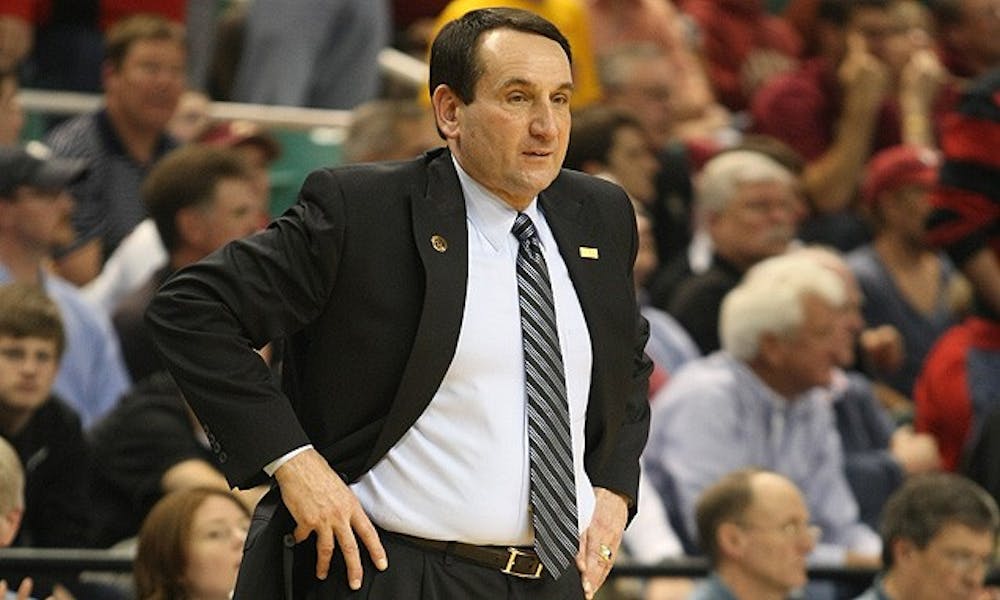There are lots of ways to blow a lead in a basketball game. Sometimes your shooters go cold and the shots stop falling. Sometimes the opponent catches fire and can’t miss.
And sometimes, like Duke did Sunday, you just hold the ball for far too long.
Clock management is one of the most important facets of basketball strategy, for coaches and players alike. Duke’s teams are usually good enough to attain big leads, and when they do, there’s nothing wrong with taking the air out of the ball and time off the clock by stalling.
But in order for that strategy to work, you’ve got to have the right combination of score and time remaining so that the time running off the clock will assuredly destroy your opponent’s chances to catch up.
Against Michigan on Sunday, head coach Mike Krzyzewski initiated the stall offense without that combination. And stalling is dangerous: It shortens the shot clock, puts increased pressure on the backcourt to create shots and takes the team completely out of its offensive rhythm.
As the clock approached the eight-minute mark in the second half, Michigan went into a 1-3-1 zone designed to counter any potential Duke efforts to run out the clock. CBS commentator Clark Kellogg noted that it’s a defense “which can flummox opponents if [they] don’t attack it with the dribble aggressively.”
It didn’t cause problems right away. Early penetration by Kyrie Irving with 8:00 on the clock led to a beautiful assist to a cutting Ryan Kelly to put Duke ahead 62-54. Nolan Smith was fouled with 28 seconds left on the shot clock on two of the next three possessions. With 6:25 to play, he drained two free throws to put the Blue Devils up 68-56.
Duke would score just once, though, in the ensuing five minutes, and couldn’t stop the Wolverines on defense.
With just under six minutes on the game clock, the stall goes into effect, and Duke stops moving on offense. Kyle Singler and Andre Dawkins take up positions in the corners while Ryan Kelly goes to stand on the low block. Smith and Irving pass the ball back and forth 40 feet from the basket. This continues for nearly 20 seconds before Irving throws an overhead pass to Dawkins in the corner, who promptly throws up, and bricks, a long 3-pointer. Scarcely anyone has moved. And with three guards on the court, Singler marooned in the corner, and only Kelly in the same zip code as the rim, there’s little reason to expect an offensive rebound.
A Wolverine basket, a Duke turnover and a Michigan miss put the ball back in Duke’s hands up by six, with 4:02 left on the clock. Four minutes. Plenty of time for the Wolverines to overcome a six-point lead.
Eighteen seconds fall off the shot clock, though, before any Duke player moves. With nine seconds to shoot, Smith is still dribbling nearly 30 feet from the hoop. He passes to Irving, who has little time to do anything but step up for a 15-foot jumper, which clangs off the back of the rim. Fortunately for Duke, Michigan’s zone has left Kelly alone, and the ball falls right into his hands for an easy putback. From there, Duke’s fortune would run dry.
Kellogg recognizes it. “That’s exactly what Michigan wants you to do. They don’t want you to attack. They want you to have the ball over your head and play standing up,” he says on air.
Michigan scores to come within six, and the Blue Devils use another possession to stall and jack up a last second three. Then, Michigan scores again, and the lead is four with 2:22 to play. The Blue Devils wait around for a full 26 seconds before starting to run their play this time, including a full ten seconds of Irving standing at midcourt, holding the ball. When Duke finally does try to move toward the rim, Singler gets trapped on the baseline and Irving dribbles out the remainder of the shot clock without ever even getting close to shooting.
The ensuing 3-pointer by Tim Hardaway, Jr. slashes the Duke lead to one, and Krzyzewski calls timeout to dictate his offensive strategy. Irving starts toward the hoop earlier than usual—with 16 seconds left to shoot—but all offensive patience has evaporated, and he kicks to Dawkins, who wastes no time in firing yet another 3-pointer.
Fortunately, Michigan tips the long rebound out of bounds, and the Blue Devils get another chance. Again, they wait 23 seconds to start any sort of offense, but this time Irving’s quickness is too much for the exhausted Wolverines, and he scores to put Duke back ahead by a three-point margin.
The thrilling shot ended a game that was never supposed to be that close, as the quest to run out the clock sucked all the excitement, and most of the points, out of Duke’s offensive possessions.
The Blue Devils didn’t pay for it this time—but they might soon.
Get The Chronicle straight to your inbox
Signup for our weekly newsletter. Cancel at any time.

